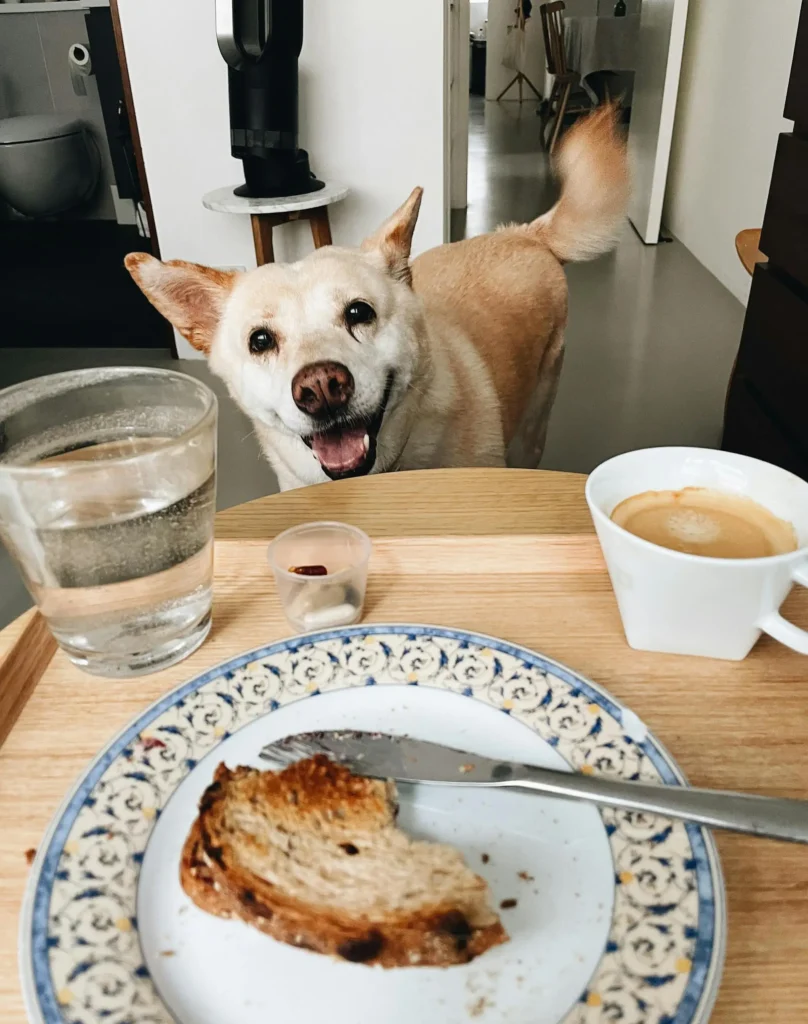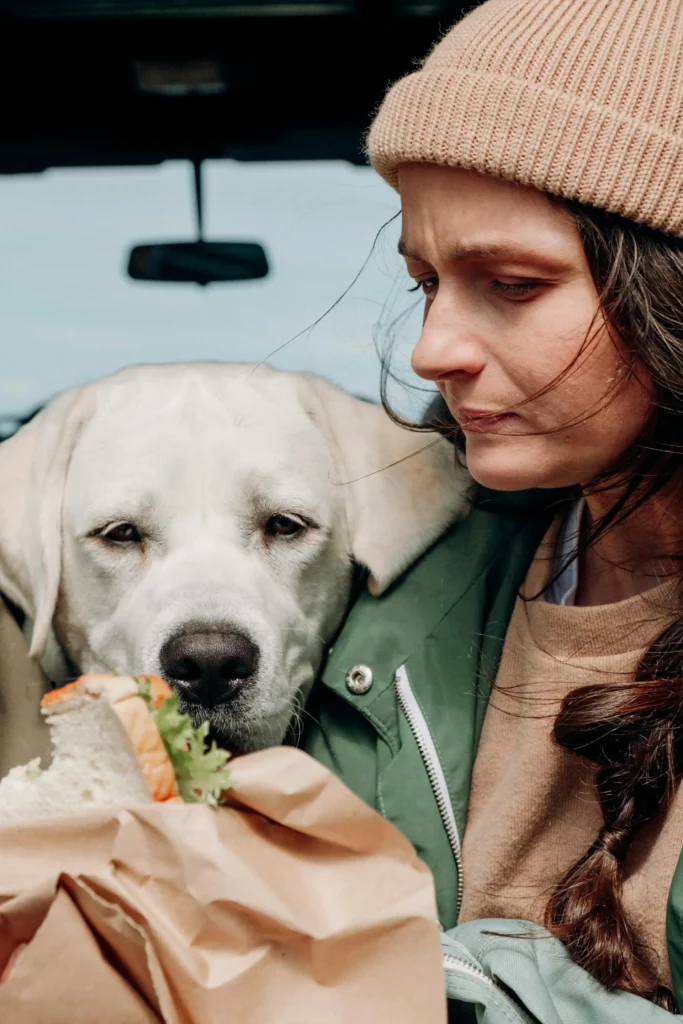Most homes have bread as a regular item, and pet owners often give their furry companions a bite or crust. But can dogs eat bread safely? This is a question many dog parents ask, especially when their pup starts drooling over toast, sandwiches, or even garlic bread.
We will investigate in this book if bread is a safe treat, the kinds of bread acceptable (and not appropriate) for dogs, and what veterinarians actually say about it.
Table of Contents
Can Dogs Eat Bread?
Yes, dogs can eat bread in moderation but not all types are safe. Usually nonpoisonous to canines, plain white or wheat bread can be offered as an occasional treat. Though, bread offers dogs nearly little to none nutritional worth and may cause health problems if consumed too much.
Bread has carbohydrates, which dogs can digest, but it also often has potentially dangerous components. Although a little slice usually won’t harm, it’s critical to know the kind of bread and what it includes.
Is Bread Bad for Dogs or Good for Dogs?
The response varies according on your dog’s intake and the kind of bread. Bread is not a health food even if it is not naturally poisonous. Although it can provide a fast energy source from carbohydrates, most commercial bread contains a lot of sugar, salt, and preservatives.
Too much bread can cause weight gain, stomach discomfort, even persistent problems including insulin resistance. Additionally a filler, bread can make your dog feel full without really providing their nutritional needs.
Varieties of Bread: Risky Versus Safe
Not every bread is made the same. Let’s define which varieties you should at all costs avoid and which ones are safer.
White Bread
Secure in extremely modest doses. Though not poisonous, it is low in nutrients and fiber.
Wheat Bread
If white bread does not include extra sugar, raisins, or seeds, a healthier alternative is available.
Whole Grain Bread
More nutrients and fiber are found in this product, along with more ingredients—look for xylitol, seeds, and preservatives.
Rye Bread
Dogs’ digestive system can be challenging for them. Many rye breads include seeds or fillers.
Sourdough Bread
This is difficult. Sourdough can be damaging to a dog’s digestive system since it ferments. It may cause gas or bloating.
Garlic Bread
Absolutely not. Garlic is toxic to dogs and can damage red blood cells.
Can Puppies Eat Bread?
Puppies have more sensitive digestive systems and even safe bread can be problematic. To foster development and growth, a puppy’s diet should include plenty of nutrients. Bread provides no vital elements; therefore, giving bread to young dogs can fill them up without giving them what they need.
If you must give a puppy bread, choose a small, plain piece without any additives.
How Much Bread Can You Give a Dog?
Bread should be given very infrequently and in small amounts. Good rule of thumb is:
| Small Dogs | 1/4 Slice |
| Medium Dogs | 1/2 Slice |
| Large Dogs | 1 Slice (max, infrequently) |
Never give bread daily. It should never substitute a good diet. Many dog owners wonder, can dogs eat bread, especially when their pets beg for a bite at the dinner table. The answer to can dogs eat bread isn’t a simple yes or no—it depends on the type of bread and the ingredients used.
Dangerous Elements to Keep an Eye Out For
Most store-bought bread contains additives that are unsafe for dogs. Avoid breads that contain:
- Xylitol (toxic sweetener)
- Onion or Garlic Powder
- Raisins (can cause kidney failure)
- Chocolate Chips
- Seeds and Nuts (particularly macadamia)
Raw bread dough is also dangerous due to yeast, which can expand in the stomach and release alcohol during fermentation.
What If Your Dog Consumed Toxic Bread?
Watch your dog very carefully if they consumed dough, garlic bread, or raisin bread. Look for indicators such:
- Vomiting
- Diarrhea
- Lethargy
- Difficulty breathing
- Seizures (in severe cases)
If any symptoms show, contact your veterinarian right away. Quick intervention is safer. Visit our pet urgent care guide for emergency symptoms and vet help.
Dog Food Options More Secure Than Bread
Give your dog healthier treats in place of bread:
- Sliced apples (no seeds)
- Carrot sticks
- Cooked sweet potatoes
- Plain rice cakes
- Homemade dog biscuits with natural ingredients
Unlike bread, these snacks provide fiber, vitamins, and minerals. Dogs can also enjoy snacks like popcorn—find out can dogs eat popcorn in our detailed guide.
Can Dogs Eat Bread Crusts?
Yes, plain crusts are generally safe, but they should still be provided in moderation. Stay away from crusts from flavored breads or those seasoned with garlic, butter, or seasonings.

It’s a common question among pet parents: can dogs eat bread without any harm? While the occasional plain piece might be okay, knowing when and how can dogs eat bread safely is key to protecting your dog’s health.
Is Homemade Bread Better for Dogs?
Made with only dog-friendly components—no salt, sugar, or yeast; homemade bread can be safer. A healthy foundation can be made using either oat flour or entire wheat. Bread should still be a rare delicacy rather than a daily necessity.
Can Dogs Be Allergic to Bread?
Yes, some dogs have allergies or tolerances to wheat or gluten. Excessive scratching, ear infections, or repeated digestive problems following bread consumption might point to a food sensitivity.
If your dog has identified allergies, always check with your veterinarian before starting any new foods.
Is Bread Helpful for Dog Stomach Upset?
Some owners provide dogs with slight digestive problems bread to firm up their stools. This is not a replacement for veterinary counsel even if it may provide temporary alleviation. Healthier choices are plain pumpkin or steamed rice.
Final Verdict: Can Dogs Eat Bread?
Yes—but it’s not recommended as a regular snack. A small piece of plain bread once in a while is usually fine for healthy adult dogs. But it offers little value and carries risk if it includes harmful ingredients. Always check the label, and opt for healthier treat alternatives when possible.
Though generally harmless, bread is not good for dogs. Bread should continue to be a rare and deliberately selected pleasure among all the better snack options available.
Always consider first before giving your dog any human food: Is this good for my dog or just practical for me?

So, can dogs eat bread without any real concern? In small, plain amounts—yes, but always remember that treats should never replace a balanced diet. When in doubt, ask your vet, and keep the question can dogs eat bread in mind before sharing a slice.
FAQs about Dogs and Bread
Can dogs eat bread every day?
No. Daily consumption can lead to health issues like obesity or GI upset.
Is toasted bread safer?
Not necessarily. Toasting removes moisture but doesn’t eliminate harmful ingredients.
Can dogs eat moldy bread?
Absolutely not. Mold can be toxic and lead to seizures or liver damage.
What about seeded bread?
Seeds like sunflower or flax may be okay, but some are toxic. Avoid multi-seed breads.
Can dogs eat buttered bread?
Avoid it. Butter adds unnecessary fat and may upset digestion.




